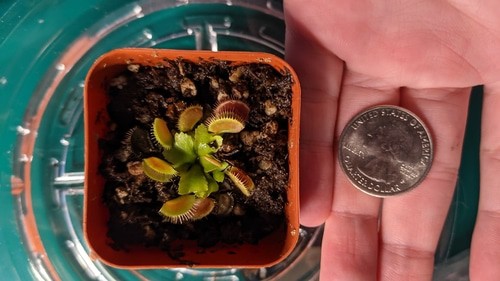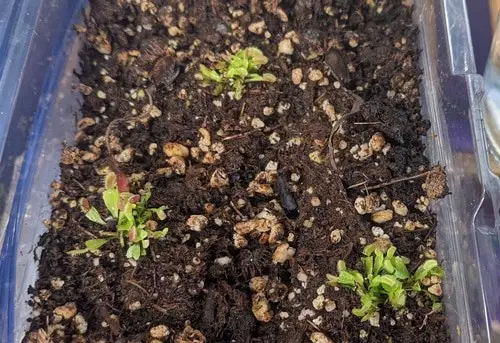Are you thinking about growing a Venus fly trap, but you are unsure about how long it will take. Overall the growth time varies depending on the type of propagation and target growth stage. Here is some initial guideline I have gathered from growing this amazing plants!
Venus fly traps growing from seeds take 2-3 weeks to germinate. The seedlings look exactly like fully grown Venus fly traps, but absolutely tiny.
If cared properly, seedlings will grow quickly over the next years following the trap size averages from the table below.
| Age | Trap Size | Overview |
| Seedlings | Tiny | The seeds will sprout, develop working traps, and grow exponentially fast |
| 1-2 years | 1/8 inch | The plant will grow rapidly, they should experience their first dormancy, and grow multiple traps at a time |
| 3-4 years | 1/4-1/2 inch | The Venus fly trap will reach maturity and start producing flowers |
| 5-7 years | 1 – 2 inches | The plant will reach its adult size, it will bloom multiple times every year in the spring |
| 7+ years | 1 – 2 inches | The plant can continue to grow and divide for many years. In the right condition they can live up to 20 years. |
Venus fly trap reach maturity between the 2nd and 4th year. When Venus fly traps are mature, they bloom and aim to propagate via seeds.
Mature Venus fly traps also commonly propagate through rhizome divisions. Dividing their roots and generating clones of themselves.
Venus fly traps can live for up to 20 years, reaching the following their maximum size in the years following maturity (year 5-7).
These are some dimensions adult Venus fly traps can reach if they are in an optimal environment.
- Trap size: 1-2 inch
- Horizontally: 5 inches in diameter
- Vertically: 1 foot
Growing Venus fly traps from seeds is the slowest method to grow a Venus fly trap. They grow much faster through rhizome divisions or leaf pulling propagation. However, these methods require you to already have a Venus fly trap.
Below, you can find a quick guide on the different propagation methods.

How to Grow Venus Fly Traps Faster: Methods to Promote Growth
Even if you are a beginner growing a Venus fly trap, there are a few things you can do to promote faster growth.
Ensure your plant receives plenty of light: Venus fly traps can survive with 4-5 hours of direct sunlight, however, they grow healthier and faster ion they receive 10+ hours of sunlight. The more light the receive the faster they will grow.
If you grow Venus fly traps under grow lights, set the times to 14-16 hours. Here is a guide to the grow lights.
Feed your plant: Venus fly traps extract key nutrients from the insects they consume in the wild. Make sure your plant has access to insects and it is consuming them regularly.
Catching one or two bugs a month with promote immense growth. If your plant is not capturing insects, feed a single insect once every 2 weeks. Here is a guide on feeding to ensure there is no harm to your plant in the process 😉
Use good quality carnivorous plant soil: Venus fly traps require special soil to survive. First, make sure you always use carnivorous plant soil. Then, make sure that the soil you buy includes silica sand or perlite.
These elements are key to providing drainage, preventing root rot, providing aeration, and overall promoting growth as the soil does not compact very easily.
Here is a link to the soil I personally use for my carnivorous plants.
Repot once a year: As most plants, require a repotting cycle is needed to change the old soil and replace with fresh one that is not hard and compacted. Repot your Venus fly trap once a year at the end of the dormancy period. Here is a guide on how to do it.
Water from the Bottom: Use the water tray method for your Venus fly trap. Place the pot inside a tray with 1-2 inches of water. Let the plant sit in that tray until it finished absorbing it. Then, refill the tray and repeat the process.
Dormancy every single year: Venus fly traps go through a dormancy (similar to hibernation) during the winter months when they grow in the wild. During this period they shrink and lose their leafs while they prepare for the spring. Even though dormant venus fly traps do not look great, once the spring comes, they get out of the state and grow faster than ever.
If you want to have an effective growing season, your Venus fly trap must go dormant for at least 2 months. Here is a guide on how to achieve it.
Tall pots: Venus fly traps have long roots that grow vertically. When grown in short pots, there is a big risk to limit growth and potentially cause rotting as the rhizome does not do well in excessive moisture. Use pots that are at least 5-6 inches in height for best results. Here are some of the ones I use in Amazon.com.
How to Propagate Venus Fly traps
Venus fly traps can propagate via seeds, divisions (vegetative propagation), leaf pullings, and flower stalk propagations. The first two occurs naturally, the other are some unique methods you can employ.
Guide to Grow a Venus flytrap from Seeds
Many online shops offer Venus flytrap seeds, make sure you buy them from a reputable source or that you harvest them yourself.
Here are some great shows that grow and sell Venus fly traps and their seeds:
- predatoryplants.com
- carnivorousplantnursery.com
- californiacarnivores.com
- petflytrap.com
- flytrapcare.com/store/
Here are the instructions on how grow Venus fly traps from seeds
First, gather some basic ingredients:
- A shallow plastic container that has drainage and tray
- Carnivorous plant soil. This is the one I use.
- A gallon of distilled water
- Light source: You can employ natural light or fluorescent LED plant lights
- Sulfur-based fungicide (optional)
- Spray bottle
Sowing Instructions
- Grab the soil and moisten it thoroughly with distilled water. The medium should be humid all around.
- Add the soil to the potting container.
- Place the potting container in the water tray and fill the tray with water.
- Optional: add small amounts of fungicide to the soil.
- Sprinkle the seeds in the potting media. Try to spread them out, but do not be too worried about separating all of them. Seedlings will be tiny and will barely take up any space. Do not bury the seeds.
- Gently press the seeds toward the grounds.
- Fill the spray bottle with distilled water and mist the soil.
- Ensure the seeds receive indirect sunlight for more than 4 hours.
- During the next few weeks, ensure the soil is always humid. Also, they should remain within this temperature range: 78 F – 90 F. As a trick to tackle this I recommend placing the tray in a closed or semi closed ziplock bag to preserve humidity.
- You will start seeing tiny Venus flytraps germinating in 3-6 weeks.
For more on Venus fly trap propagation, here is a guide.
Venus Fly Trap Rhizome Divisions
Leaf Pulling Propagation
You can also propagate Venus fly traps through leaf pullings.
If you are able to extract a Venus flytrap leaf attached to part of the rhizome it is possible you can produce a whole new plant.
Here are some general instructions:
- Place a bare root Venus flytrap on top of a surface.
- Identify a healthy leaf on the outer layer of leaves in the rhizome.
- Grab the leaf from the top and gently but firmly pull in downwards. The leaf should have a small portion of the rhizome in its base.
- Collect a couple of leaf cuttings to increase your chances of propagating the plant.
- Place the leaf cuttings in a container with humid carnivorous plant soil by laying them on their side.
- Cover the base of the leaf-cutting with some of the soil.
- Provide the standard Venus flytrap care to this leaf cuttings. They should have access to sunlight, a humid environment, and adequate amounts of nutrient-free water.

Leaf cutting/pullings tend to grow faster than Venus fly traps growing from seeds. Still, they can take a couple of months to show any sign of growth.
Flower Stalk Propagation
You can also propagate Venus flytraps through flower stalk cuttings.
Once your plant is mature, it will produce flowers. Before the plant blooms you can cut off those flower stalks to grow new plants.
You can cut the stalks into 2-3 inch segment and plant them in moist soil. if you keep them at the right humidity, they can start developing roots.
This method is not difficult, but the effectivity rate is low, so make sure you follow the complete instructions in this guide for flower stalk propagation.
Venus fly trap propagations through flower stalks usually take 2-3 months to show growth.
Venus Fly Trap Care Considerations
Healthy Venus fly traps can live for many many years.
This list of care tips will help you ensure your plant remains healthy:
- Light: Optimally they should receive 12 hours of sunlight, and the minimum is 6 hours of light. The light source might be natural light or artificial lighting (plant lights)
- Water: Venus flytraps must be watered with pure water only, such as rainwater, distilled water, and reverse osmosis water. Tap water and bottled water kill carnivorous plants.
- The soil of the plant must always remain moist. Always keep the ground humid, but do not flood. Venus flytraps do not grow in swamps.
- Soil: Employ nutrient-free soil for carnivorous plants. Never employ enriched soil, full of fertilizers. This article covers many soil options for Venus flytraps.
- Feeding: Venus flytraps do not need to capture insects to survive, but they benefit from them greatly. Place Venus flytraps outdoors, and they will have plenty of access to food. Also, consider feeding your plant to provide extra nutrients.
- Fertilizers: Do not fertilize Venus flytraps. The chemicals in the fertilizers can hurt the plant
- Flowers: After reaching maturity, Venus flytraps start producing flowers every spring. Skipping it allows for further growth and development.
- Dormancy: Venus flytraps must undergo a dormancy period for 2-3 months during the winter. Venus flytraps must go dormant every winter to remain healthy and live for many years. Ensure your plant will experience this resting period by placing them in a cold location. For example, outdoors, in a cold garage, or porch.
You can also encourage quick growth for your plant. Here are the tips to grow big venus fly traps.

